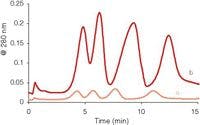Making Elephants Fly
LCGC North America
When good things are given to us, or when we have never known life without them, we rarely appreciate them fully. This truth applies to many areas of life, but tends to be particularly evident with respect to modern conveniences and technological advances. Anyone with a teenager who thinks having a cell phone or an iPod is a requirement, not a luxury, knows this; pointing out that every generation until this one grew up without such devices rarely elicits more than eye rolling. Young people are not the only ones who take things for granted, however. When was the last time most of us truly felt grateful for our flush toilets or hot showers? Probably shortly after a camping trip or when the water heater broke.
When good things are given to us, or when we have never known life without them, we rarely appreciate them fully. This truth applies to many areas of life, but tends to be particularly evident with respect to modern conveniences and technological advances. Anyone with a teenager who thinks having a cell phone or an iPod is a requirement, not a luxury, knows this; pointing out that every generation until this one grew up without such devices rarely elicits more than eye rolling. Young people are not the only ones who take things for granted, however. When was the last time most of us truly felt grateful for our flush toilets or hot showers? Probably shortly after a camping trip or when the water heater broke.

Laura Bush
The point is not just that it is good to appreciate the technologies we use every day, but also to value the ingenuity or outright brilliance of the people who invented them, developed them, or figured out the underlying scientific or technological concepts that made them possible. That applies to everyday conveniences as well as the tools of the analytical laboratory.
The recent death of John B. Fenn gives us an opportunity to appreciate a modern pioneer whose breakthroughs enabled the development of methods that have become essential in analytical chemistry. Not only is it impossible to talk about modern LC–MS without considering Fenn's contributions, but the whole field of proteomics would not exist without his work on electrospray ionization (ESI), which won him a share of the Nobel Prize for chemistry in 2002. Fenn's famous phrase, "we made elephants fly" — alluding to the challenge of mobilizing large protein molecules so they could be analyzed by mass spectrometry — captures the significance of what ESI made it possible to do. A quick look at the list of citations of Fenn's seminal 1989 article (1) provides a glimpse of the impact of his work on modern protein research. And his impressive research was not limited to ESI; he could just have easily won a Nobel for his work on molecular beams.
While we stop to appreciate the magnitude of Fenn's achievements, it is also worth taking note of his views on science education. In a 2005 interview, Fenn said that too many students — and their parents — look at education simply as a means to getting a better job. "We've transformed education into vocational training," he said. "That's entirely the wrong emphasis. [Students] ought to go to college to get educated, to learn how to think."
Fenn also expressed dismay at the way science is taught today. When he took introductory chemistry, the textbook was 300 pages long. Twenty years later, the textbook had grown to 700 pages; today it is 1100. This approach to textbooks and teaching assumes that because more chemistry is known now than 50 years ago, students today must learn more than they did then. "The fallacy of this approach becomes apparent when you realize the student's brain is the same as it was 50 years ago and will be the same 50 years from now," he said.
Instead of trying to pack students' brains with all that is known to science, Fenn continued, instructors should select from that rich material to fulfill their primary purpose, which is to teach their students to think. "The purpose of the university experience is to develop young people's minds, not to make them experts in a particular field," he concluded.
If we heed that advice, perhaps we will see more John Fenns in the future, who will bring new technological advances for the generations to come. In the meantime, let's take our hats off to one of the great scientific minds of our time, and pause for a moment to appreciate the tools of today's laboratory that developed as a result of his research.
Laura Bush
Editorial Director
Reference
(1) J.B. Fenn, M. Mann, C.K. Meng, S.F. Wong, and C.M. Whitehouse, Science 246(4926), 64–71 (1989).

Evaluating Body Odor Sampling Phases Prior to Analysis
April 23rd 2025Researchers leveraged the advantages of thermodesorption, followed by comprehensive two-dimensional gas chromatography coupled to time-of-flight mass spectrometry (GC×GC/TOF-MS), to compare and assess a variety of sampling phases for body odor.

.png&w=3840&q=75)

.png&w=3840&q=75)



.png&w=3840&q=75)



.png&w=3840&q=75)













